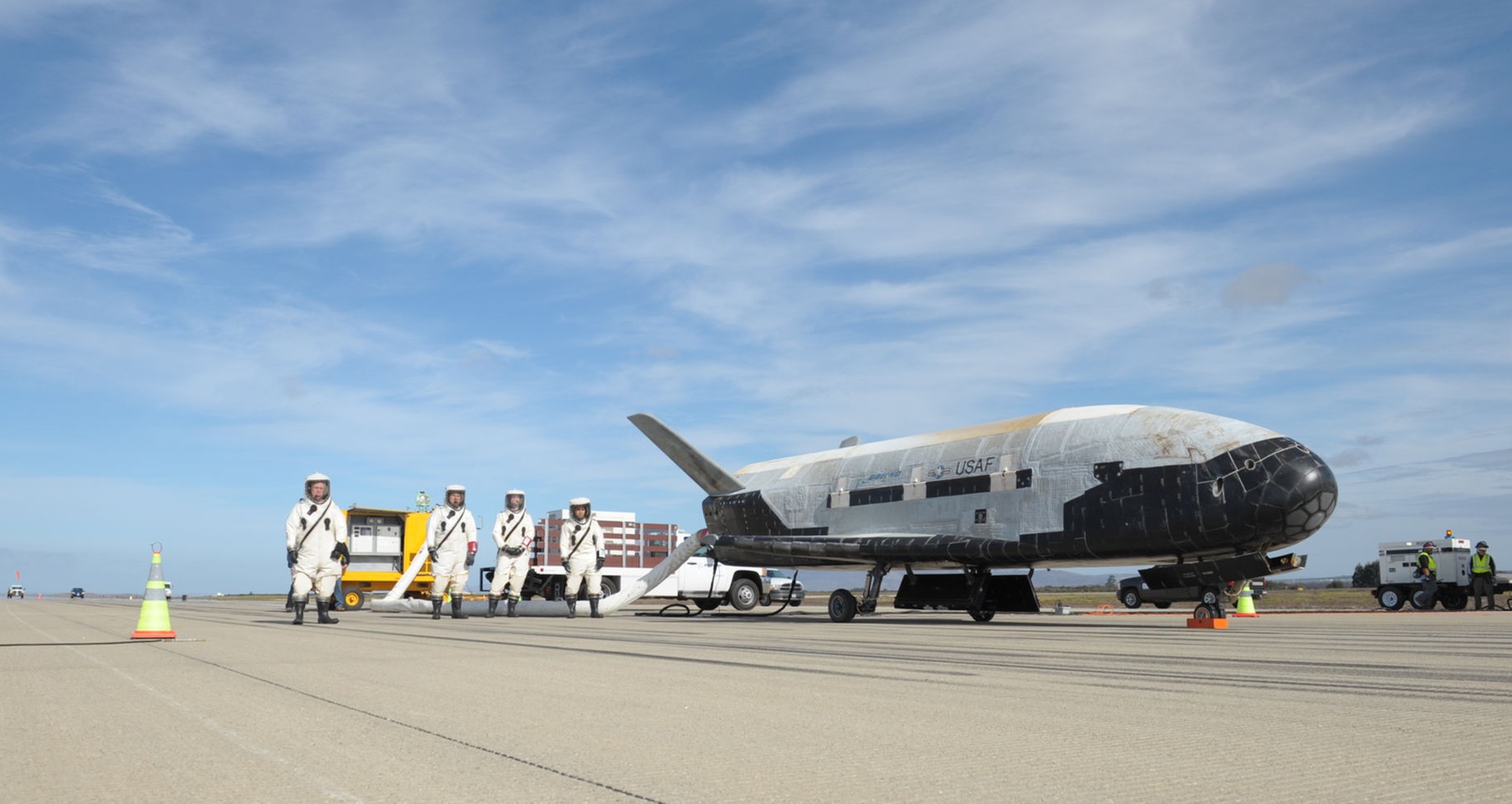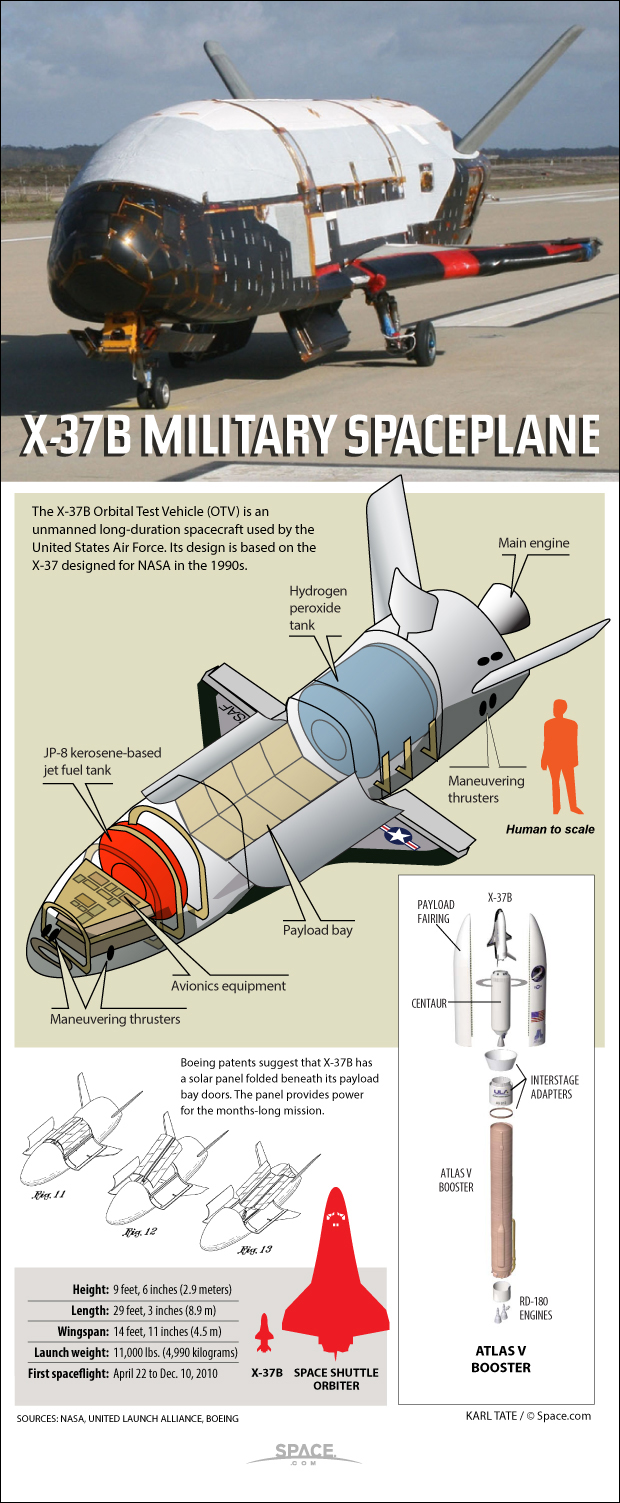
US Air Force's X-37B Space Plane to Launch on Secret Mission Sept. 7
The U.S. Air Force's enigmatic space drone — the X-37B space plane — is heading for a Sept. 7 liftoff, according to military officials.
In an Air Force Space Command statement, officials with the Air Force Rapid Capabilities Office said they are undergoing final launch preparations for the fifth mission of the X-37B Orbital Test Vehicle (OTV) program. The Air Force has two robotic and reusable X-37B space planes, and has flown both twice.
"The many firsts on this mission make the upcoming OTV launch a milestone for the program," said Randy Walden, director of the Air Force Rapid Capabilities Office, said in the statement. "It is our goal to continue advancing the X-37B OTV so it can more fully support the growing space community." [The X-37B Space Plane: 6 Surprising Facts]
For the first time in the program's history, the unpiloted space plane will launch on a privately built SpaceX Falcon 9 rocket. Four previous X-37B missions were all lofted by United Launch Alliance (ULA) Atlas V rockets. ULA is a joint venture by Lockheed Martin and Boeing. Late last week, the Falcon 9 booster that will launch the X-37B space plane was test-fired, according to SpaceX.
Also, the fifth mission, dubbed OTV-5, will be launched into, and landed from, a higher-inclination orbit than in prior missions "to further expand the X-37B's orbital envelope," according to the Air Force statement.

Mystery manifest

What this X-37B space-plane mission will carry is largely classified.
However, it is known that the OTV missions are dedicated to advancing the X-37B's performance and flexibility as a space technology demonstrator and host platform for experimental payloads.
Get the Space.com Newsletter
Breaking space news, the latest updates on rocket launches, skywatching events and more!
"This mission carries small satellite ride shares and will demonstrate greater opportunities for rapid space access and on-orbit testing of emerging space technologies," the Air Force statement added.
"Building upon the fourth mission and previous collaboration with experiment partners, this mission will host the Air Force Research Laboratory Advanced Structurally Embedded Thermal Spreader [known as ASETS-11] payload to test experimental electronics and oscillating heat pipe technologies in the long duration space environment," the statement explained.
Long-duration record
Flights of the craft have repeatedly broken its own long-duration record.
- The first OTV mission began April 22, 2010, and concluded Dec. 3, 2010, after 224 days in orbit.
- The second OTV mission began March 5, 2011, and concluded June 16, 2012, after 468 days in orbit.
- The OTV-3 mission chalked up nearly 675 days in orbit when it landed Oct. 17, 2014. That mission also was the first to reuse an X-37B space plane.
- On May 7, 2017, OTV-4 landed at NASA's Kennedy Space Center Shuttle Landing Facility — a first for the program, as all previous OTV missions ended with a tarmac touchdown at Vandenberg Air Force Base in California. The OTV-4 mission conducted in-orbit experiments for 718 days during its mission, extending the total time spent in orbit for the OTV program to 2,085 days.
Built by Boeing
Built by Boeing, the robotic X-37B space plane is one of two known reusable OTV vehicles that constitute the space plane "fleet." [How the X-37B Space Plane Works (Infographic)]
The reusable military space plane, which looks like a miniature version of NASA's now-retired space shuttle orbiter, is 29 feet (8.8 meters) long and 9.6 feet (2.9 m) tall, and has a wing span of nearly 15 feet (4.6 m).
The space drone has a payload bay about the size of a pickup-truck bed that can be outfitted with a robotic arm. It has a launch weight of 11,000 lbs. (5,000 kilograms) and is powered on orbit by gallium arsenide solar cells with lithium-ion batteries.
Leonard David is author of "Mars: Our Future on the Red Planet," published by National Geographic. The book is a companion to the National Geographic Channel series "Mars." A longtime writer for Space.com, David has been reporting on the space industry for more than five decades. Follow us @Spacedotcom, Facebook or Google+. This version of this story was posted on Space.com.
Join our Space Forums to keep talking space on the latest missions, night sky and more! And if you have a news tip, correction or comment, let us know at: community@space.com.

Leonard David is an award-winning space journalist who has been reporting on space activities for more than 50 years. Currently writing as Space.com's Space Insider Columnist among his other projects, Leonard has authored numerous books on space exploration, Mars missions and more, with his latest being "Moon Rush: The New Space Race" published in 2019 by National Geographic. He also wrote "Mars: Our Future on the Red Planet" released in 2016 by National Geographic. Leonard has served as a correspondent for SpaceNews, Scientific American and Aerospace America for the AIAA. He has received many awards, including the first Ordway Award for Sustained Excellence in Spaceflight History in 2015 at the AAS Wernher von Braun Memorial Symposium. You can find out Leonard's latest project at his website and on Twitter.









